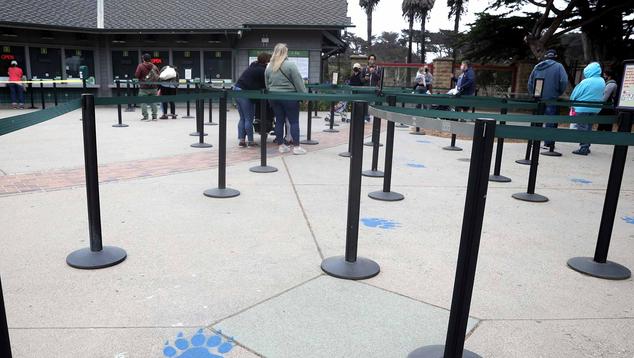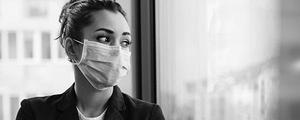Story Highlights
- Two-thirds now say pandemic is getting worse, doubled from a month ago
- After dwindling since March, social distancing has leveled off recently
- Vigilant mask usage prevalent but still far from universal
WASHINGTON, D.C. -- Americans have taken note of the sharp increase in COVID-19 cases across the U.S., saying the situation is worsening, but they have not yet reacted by cutting themselves off from personal interactions. Rather, Americans are maintaining a reduced level of self-isolation after being much more vigilant in March and April.
- The percentage of Americans who perceive the coronavirus situation is worsening in the country more than doubled in June, from 31% for the week ending June 7 to 65% at the end of June. This perception has since remained about the same, and registered 66% in Gallup's latest wave of interviewing, conducted July 6-12.
- Meanwhile, the percentage saying they are having little or no contact with non-household members has been steady in the low to mid-40s after gradually falling from 75% in early April. Forty-four percent of Americans now say they are completely (10%) or mostly (34%) isolating themselves.

Line graph. Weekly trends since mid-March in percentages of Americans who perceive the coronavirus situation is getting worse and the percentage saying they are completely or mostly isolating themselves from other household members.
Similar to the trend in self-reported isolation from others, the trends in those reporting they are avoiding various situations involving personal interactions are also holding steady at June levels.
About seven in 10 say they are avoiding travel, roughly six in 10 are avoiding going to public places such as stores and restaurants, and just over half are avoiding small gatherings with friends and family. These figures are nearly identical to what Gallup found in early June, which were down from much higher levels in early April.

Line graph. Weekly trends in percentages of Americans who, due to the coronavirus, are avoiding public places (now 62%), avoiding small gatherings (52%) and avoiding traveling. All three behaviors have leveled off in June and July after falling from high point in March and April.
Still Room for More Frequent Use of Masks
Now that a mounting number of health officials and political leaders from both parties are urging, and in some cases requiring, people to wear face masks, many Americans may be looking more to this strategy than to sheltering at home to protect themselves from exposure to the coronavirus.
The percentage of Americans reporting they wore a mask in the past seven days was already high at the start of June (83%) but has crept up further to 88% in the week ending July 12.

Line graph. Weekly trend in the percentage of Americans wearing a face mask in the past seven days. Figure is 88% for the week ending July 12, up from 84% at the start of June and 51% in early April.
Still, barely three-fourths of Americans say they "always" (47%) or "very often" (27%) wear a mask when outside their home. While not all public settings require mask usage, it's likely that the people wearing them at least "very often" are more compliant than others with recommendations to wear them when in close proximity to other people.
Another 11% of Americans say they "sometimes" wear a mask, and 3% "rarely" do -- with a resistant 13% saying they "never" wear one.
Gallup first asked this question two weeks ago, and there has been no change since then in the frequency of Americans' mask wearing.
Worry Up Most Among Democrats, Women and College Graduates
All major demographic subgroups of Americans are expressing more concern today than in early June that the coronavirus situation is worsening. However, the increase is particularly pronounced among Democrats, women and college graduates. By contrast, levels of concern increased to a similar degree across all age groups.
| Jun 1-7 | Jul 6-12 | Change | |||||||||||||||||||||||||||||||||||||||||||||||||||||||||||||||||||||||||||||||||||||||||||||||||
|---|---|---|---|---|---|---|---|---|---|---|---|---|---|---|---|---|---|---|---|---|---|---|---|---|---|---|---|---|---|---|---|---|---|---|---|---|---|---|---|---|---|---|---|---|---|---|---|---|---|---|---|---|---|---|---|---|---|---|---|---|---|---|---|---|---|---|---|---|---|---|---|---|---|---|---|---|---|---|---|---|---|---|---|---|---|---|---|---|---|---|---|---|---|---|---|---|---|---|---|
| % | % | pct. pts. | |||||||||||||||||||||||||||||||||||||||||||||||||||||||||||||||||||||||||||||||||||||||||||||||||
| Men | 32 | 60 | +28 | ||||||||||||||||||||||||||||||||||||||||||||||||||||||||||||||||||||||||||||||||||||||||||||||||
| Women | 29 | 72 | +43 | ||||||||||||||||||||||||||||||||||||||||||||||||||||||||||||||||||||||||||||||||||||||||||||||||
| 18-34 years old | 39 | 75 | +36 | ||||||||||||||||||||||||||||||||||||||||||||||||||||||||||||||||||||||||||||||||||||||||||||||||
| 35-54 years old | 29 | 62 | +33 | ||||||||||||||||||||||||||||||||||||||||||||||||||||||||||||||||||||||||||||||||||||||||||||||||
| 55 and older | 26 | 63 | +37 | ||||||||||||||||||||||||||||||||||||||||||||||||||||||||||||||||||||||||||||||||||||||||||||||||
| College degree | 37 | 81 | +44 | ||||||||||||||||||||||||||||||||||||||||||||||||||||||||||||||||||||||||||||||||||||||||||||||||
| No degree | 27 | 58 | +31 | ||||||||||||||||||||||||||||||||||||||||||||||||||||||||||||||||||||||||||||||||||||||||||||||||
| Democrats | 46 | 97 | +51 | ||||||||||||||||||||||||||||||||||||||||||||||||||||||||||||||||||||||||||||||||||||||||||||||||
| Independents | 30 | 61 | +31 | ||||||||||||||||||||||||||||||||||||||||||||||||||||||||||||||||||||||||||||||||||||||||||||||||
| Republicans | 11 | 34 | +23 | ||||||||||||||||||||||||||||||||||||||||||||||||||||||||||||||||||||||||||||||||||||||||||||||||
| Percentage saying the situation is getting "a lot" or "a little" worse | |||||||||||||||||||||||||||||||||||||||||||||||||||||||||||||||||||||||||||||||||||||||||||||||||||
| Gallup Panel, 2020 | |||||||||||||||||||||||||||||||||||||||||||||||||||||||||||||||||||||||||||||||||||||||||||||||||||
In terms of current social distancing practices, Democrats, women and college graduates are also the most likely to report vigilant social distancing behavior, including isolating themselves, avoiding going out and wearing masks.
| Completely/Mostly isolated | Avoided public places | Avoided small gatherings | Worn mask always/very often | ||||||||||||||||||||||||||||||||||||||||||||||||||||||||||||||||||||||||||||||||||||||||||||||||
|---|---|---|---|---|---|---|---|---|---|---|---|---|---|---|---|---|---|---|---|---|---|---|---|---|---|---|---|---|---|---|---|---|---|---|---|---|---|---|---|---|---|---|---|---|---|---|---|---|---|---|---|---|---|---|---|---|---|---|---|---|---|---|---|---|---|---|---|---|---|---|---|---|---|---|---|---|---|---|---|---|---|---|---|---|---|---|---|---|---|---|---|---|---|---|---|---|---|---|---|
| % | % | % | % | ||||||||||||||||||||||||||||||||||||||||||||||||||||||||||||||||||||||||||||||||||||||||||||||||
| Men | 41 | 55 | 49 | 65 | |||||||||||||||||||||||||||||||||||||||||||||||||||||||||||||||||||||||||||||||||||||||||||||||
| Women | 48 | 69 | 55 | 82 | |||||||||||||||||||||||||||||||||||||||||||||||||||||||||||||||||||||||||||||||||||||||||||||||
| 18-34 years old | 51 | 66 | 50 | 77 | |||||||||||||||||||||||||||||||||||||||||||||||||||||||||||||||||||||||||||||||||||||||||||||||
| 35-54 years old | 40 | 62 | 51 | 69 | |||||||||||||||||||||||||||||||||||||||||||||||||||||||||||||||||||||||||||||||||||||||||||||||
| 55 and older | 43 | 60 | 54 | 74 | |||||||||||||||||||||||||||||||||||||||||||||||||||||||||||||||||||||||||||||||||||||||||||||||
| College degree | 53 | 71 | 59 | 88 | |||||||||||||||||||||||||||||||||||||||||||||||||||||||||||||||||||||||||||||||||||||||||||||||
| No degree | 40 | 58 | 48 | 66 | |||||||||||||||||||||||||||||||||||||||||||||||||||||||||||||||||||||||||||||||||||||||||||||||
| Democrats | 58 | 82 | 72 | 96 | |||||||||||||||||||||||||||||||||||||||||||||||||||||||||||||||||||||||||||||||||||||||||||||||
| Independents | 45 | 60 | 45 | 70 | |||||||||||||||||||||||||||||||||||||||||||||||||||||||||||||||||||||||||||||||||||||||||||||||
| Republicans | 28 | 43 | 36 | 51 | |||||||||||||||||||||||||||||||||||||||||||||||||||||||||||||||||||||||||||||||||||||||||||||||
| Gallup Panel, July 6-12, 2020 | |||||||||||||||||||||||||||||||||||||||||||||||||||||||||||||||||||||||||||||||||||||||||||||||||||
Bottom Line
Americans are mindful of the news that COVID-19 cases are spiking to new highs in much of the country, but this hasn't sent them indoors. While it's not clear how much mask adoption may account for this, it's likely that after months of adhering to advice that the best way to avoid infection was to stay home, many are now prioritizing the advice that face masks work.
Learn more about how the Gallup Panel works.




